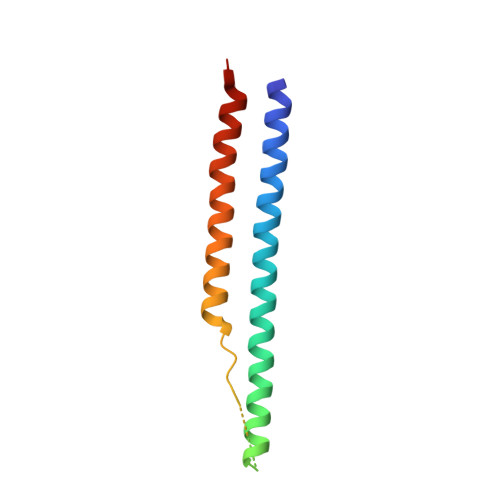Core Structure of S2 from the Human Coronavirus NL63 Spike Glycoprotein
Zheng, Q., Deng, Y., Liu, J., Hoek, L.V., Berkhout, B., Lu, M.(2006) Biochemistry 45: 15205-15215
- PubMed: 17176042
- DOI: https://doi.org/10.1021/bi061686w
- Primary Citation of Related Structures:
2IEQ - PubMed Abstract:
Human coronavirus NL63 (HCoV-NL63) has recently been identified as a causative agent of acute respiratory tract illnesses in infants and young children. The HCoV-NL63 spike (S) protein mediates virion attachment to cells and subsequent fusion of the viral and cellular membranes. This viral entry process is a primary target for vaccine and drug development. HCoV-NL63 S is expressed as a single-chain glycoprotein and consists of an N-terminal receptor-binding domain (S1) and a C-terminal transmembrane fusion domain (S2). The latter contains two highly conserved heptad-repeat (HR) sequences that are each extended by 14 amino acids relative to those of the SARS coronavirus or the prototypic murine coronavirus, mouse hepatitis virus. Limited proteolysis studies of the HCoV-NL63 S2 fusion core identify an alpha-helical domain composed of a trimer of the HR segments N57 and C42. The crystal structure of this complex reveals three C42 helices entwined in an oblique and antiparallel manner around a central triple-stranded coiled coil formed by three N57 helices. The overall geometry comprises distinctive high-affinity conformations of interacting cross-sectional layers of the six helices. As a result, this structure is unusually stable, with an apparent melting temperature of 78 degrees C in the presence of the denaturant guanidine hydrochloride at 5 M concentration. The extended HR regions may therefore be required to prime the group 1 S glycoproteins for their fusion-activating conformational changes during viral entry. Our results provide an initial basis for understanding an intriguing interplay between the presence or absence of proteolytic maturation among the coronavirus groups and the membrane fusion activity of their S glycoproteins. This study also suggests a potential strategy for the development of improved HCoV-NL63 fusion inhibitors.
Organizational Affiliation:
Department of Biochemistry, Weill Medical College of Cornell University, New York, New York 10021, USA.
















